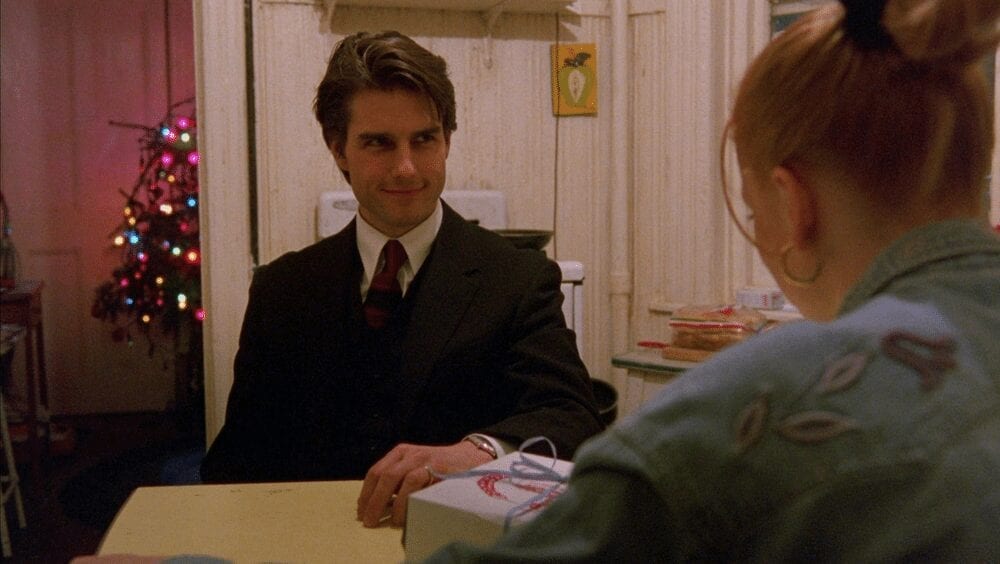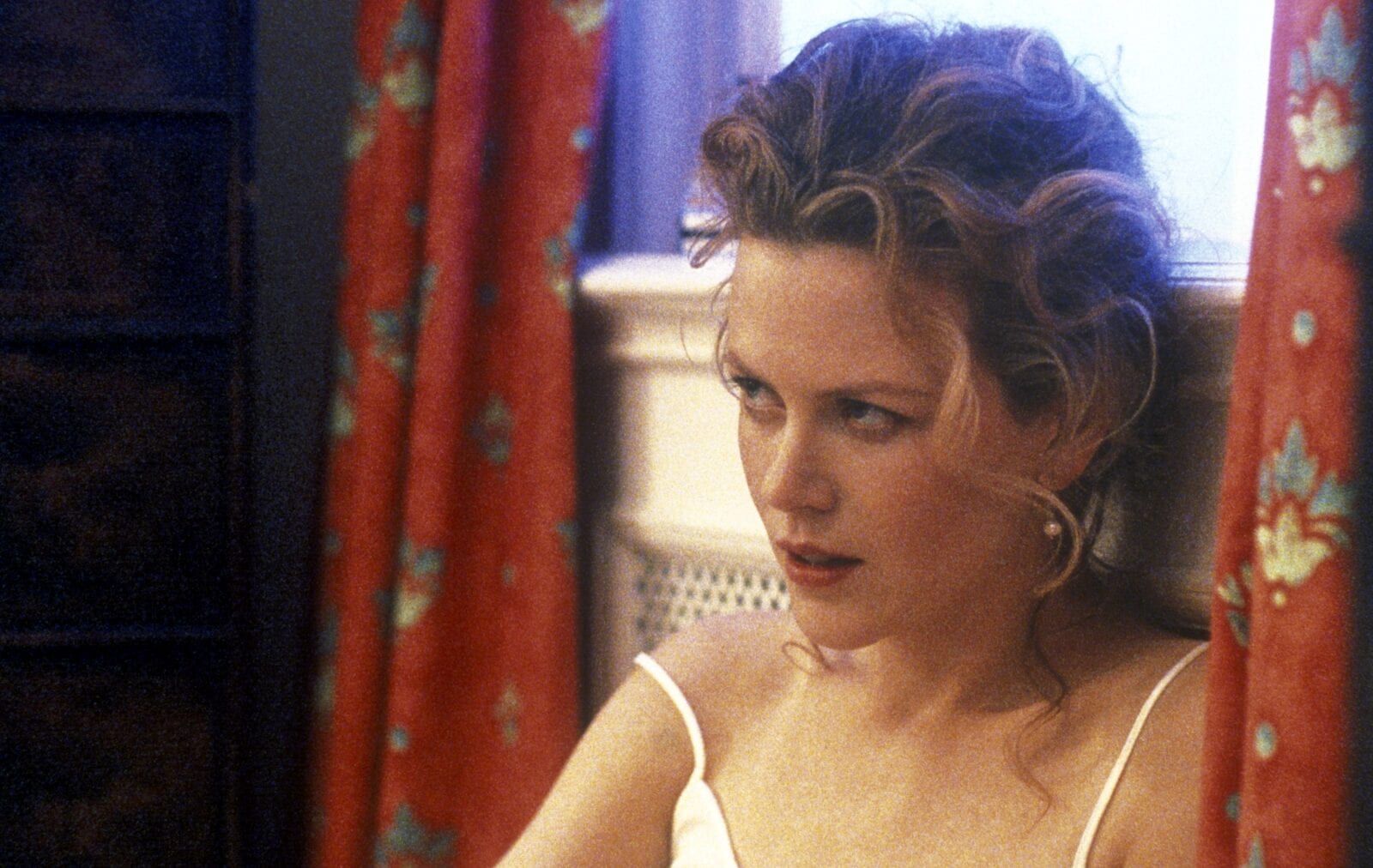In a short documentary that screened prior to the 20th-anniversary re-release of Eyes Wide Shut, Warner Bros. VP Julian Senior reveals how Stanley Kubrick was “fascinated by holidays.” The director, who notoriously developed a fear of flying, just didn’t see the appeal. “What’s the point of holidays? What do they do?” He couldn’t grasp the concept that people would want a break from normal day-to-day life, to experience something new and exciting. It’s funny, then, that for his last film, he chose to dissect the subject of marital affairs – in all ways but literal, an escapist act not too dissimilar from taking a holiday at all.
In Eyes Wide Shut, Stanley Kubrick’s sixteenth and relentlessly horny final film, a well-to-do couple reside in a swanky New York apartment with their young daughter. The father, Bill (Tom Cruise), is a doctor, while his wife, Alice (Nicole Kidman), is a stay-at-home mother. One night, they attend a Christmas party, where Alice is hit on by and dances with another man, while two young models hit on Bill. When they return home, they exchange tales of temptation; Bill says that he would never be jealous of his wife, as women are naturally inclined to fidelity, and he is shocked to hear that last year on holiday Alice very nearly cheated on him when she felt an overwhelming sexual attraction to another man. Dazed by this hypothetical cuckolding, Bill wanders into the night and, through a series of increasingly bewildering events, finds himself embroiled in an underground sex cult.
Everything about Eyes Wide Shut feels unbearably slow – but always to the film’s benefit. The film’s production, at 400 days, holds the Guinness World Record for the longest continuous film shoot. The film itself is longer than a typical film, at nearly 3 hours. It’s adapted from a novel named “Dream Story,” and certainly echoes the perpetual, achronological feeling of dreams. And, the fact that Nicole Kidman and Tom Cruise had been married in real life for nine years already gives their on-screen credence a serious boost, with a believable, lived-in quality. Nicole Kidman, as housewife Alice, delivers her lines at a glacial pace, sinking deeply into her sentences like someone has programmed her on 0.5x speed.The slow and sensual line delivery is like foreplay, and she constantly looks like she’s on the verge of an orgasm that never quite arrives. It’s frustrating to watch, but deliciously effective.

Every aspect of filmmaking drives forcefully and headily into the same goal. Kubrick’s innovative cinematography used fairy lights and Christmas trees to provide light in most scenes, washing each frame with a heady, sensual, grainy glow, feeling at once cosy yet illicit. The relentless ¾ time signature of the opening music, Shostakovich’s Waltz No. 2, immediately signifies the presence of a third party involved. One, two, three. One, two, three. The balance is tipped from the very start, and this theme twirls leisurely throughout the film’s 165-minute run time. The editing itself allows scene changes to slowly overlap and fade into one another like writhing, nameless bodies, mirroring the characters’ restlessness and constant moving, writhing, fidgeting. Both thematically wild yet technically dreamlike, Eyes Wide Shut is a feat of filmmaking, while simultaneously a film that has evolved in the twenty years since its premiere.
Watching the film in 2019, Bill and his fragile masculinity is interesting to analyse. He decides against sleeping with the sex worker he meets on the street but pays her anyway. He politely turns down a patient’s grieving daughter who proposes an affair with him. He saves the life of a young woman who overdoses and, later, tirelessly avenges her death. He flashes his doctor’s card at any given moment. Essentially, he is desperate to prove that he is a Good Guy. Perhaps in 1999, audiences would have thought Bill was a Good Guy. Today, his flaws shine through, and his veneer of respectability and ostensible kindness seem thin and weak. Though we may still find him charming and handsome, our woke brains are programmed to see through his veneer of old-fashioned, gentlemanly wiles. We know that he was spurred on to explore the route of adultery because, among other reasons, his wife threatened his power over him, and his sexuality was threatened by street thugs. Also, somehow, the now-infamous images of Nicole Kidman once her divorce to Tom Cruise was finalised in 2001, sticks in our minds watching the film 20 years later. The jubilant, relieved Kidman, free from Cruise and his increasing involvement with Scientology, was glossy-mag fodder throughout the noughties, and so to have Eyes Wide Shut existing as a twisted, erotic, snapshot relic of their very public courtship undeniably informs our contemporary viewing.
Upon its release, Eyes Wide Shut was radical. There was a dispute about its state of completion (Kubrick died six days after the final edits), and its scenes of group sex needed digitally altering for American audiences. But what piques my interest now, which may not have been clear 20 years ago, is how the film’s release seemed to coincide with the death of Generation X and all its affectless extremity, and the ushering in of Millennial sensibilities. Famously, the film ends with Bill and Alice Christmas shopping with their daughter. “There is something very important we need to do as soon as possible,” Alice says to her husband. “What’s that?” Bill replies. “Fuck.” The screen snaps to black. What, you mean, they’re just going to get back together like nothing had happened? He’s going to go home and have sex with his wife, instead of being murdered or inducted into the sexual ritual? Maybe–just maybe–why the film felt so radical is that it ends with the rather vanilla conclusion of Bill confessing and reconciling with his wife. It signalled away from lack of forgiveness, feeling and redemption of preceding films, and forged a path towards what we now accept to be fairly normal. Either way, Kubrick’s final parting gift is a filthy, labyrinthine odyssey through desire and atonement – and I can’t wait to see how it can be ingested differently in 2039.
Words by Steph Green
